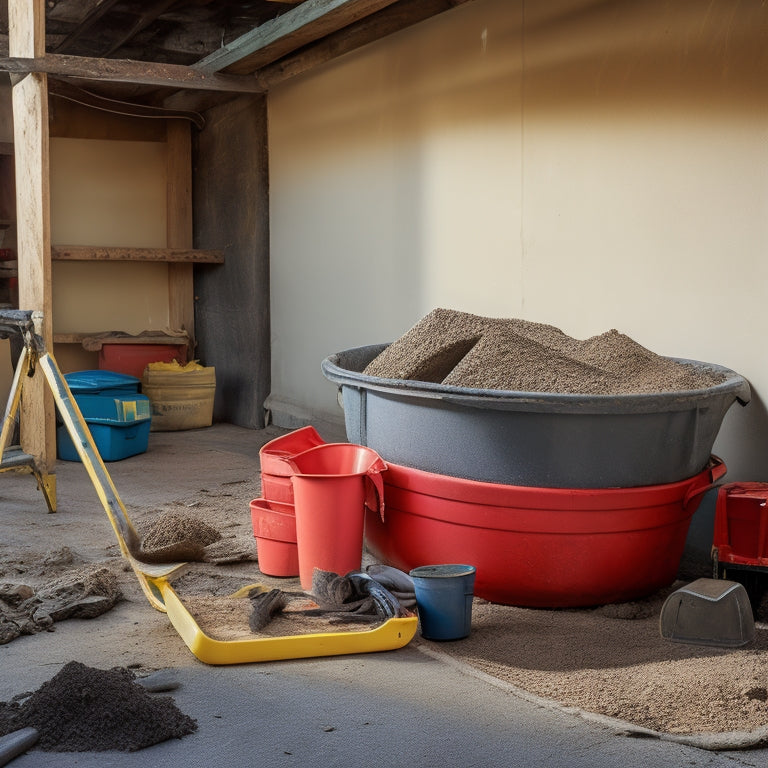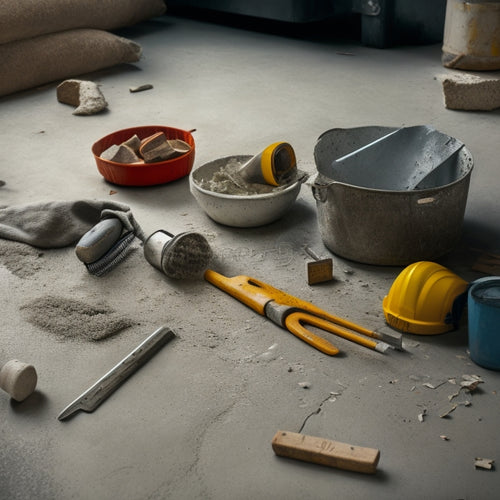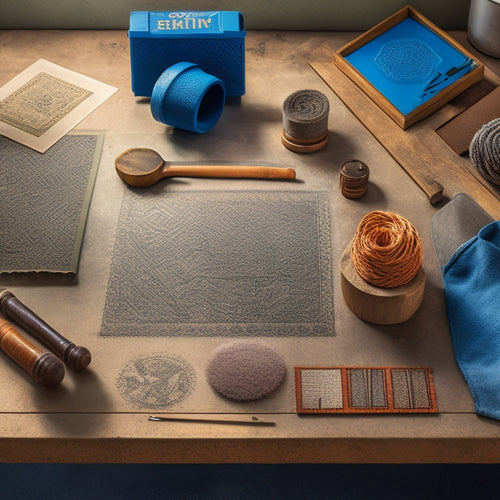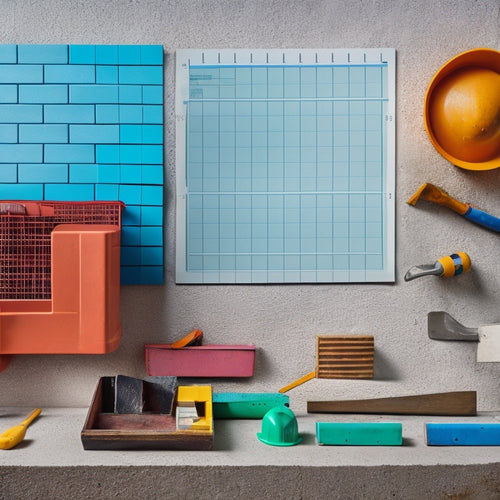
What Tools Do I Need for Mixing Concrete
Share
You'll need a combination of essential hand tools, a suitable mixing bucket, power tools, safety equipment, and measuring and testing tools to efficiently mix concrete that meets your project's requirements. Start with a sturdy trowel and mixing stick for combining cement, water, and aggregates, and a reliable mixing bucket that can hold 1.5 to 2 times the volume of concrete needed. Add a power drill and mixer combo for efficient mixing, and don't forget personal protective equipment like safety glasses and gloves. With these basics covered, you can move forward with confidence, and uncover the finer details to guarantee a successful mix.
Key Takeaways
• A sturdy trowel is essential for scooping, mixing, and dumping concrete, efficiently blending coarse aggregates like gravel and crushed stone.
• A mixing stick or paddle ensures thorough mixing, breaks up clumps, and prevents segregation when working with finer aggregates like sand or pea gravel.
• A durable mixing bucket with a non-stick surface, rounded shape, and ergonomic design aids in efficient mixing, reduces waste, and improves user experience.
• Power tools like drill and mixer combos with high-torque drills, sturdy mixing buckets, and robust paddles enhance mixing efficiency and handle demanding tasks.
• Safety equipment including personal protective equipment (PPE) like safety glasses, dust masks, gloves, and steel-toed boots is crucial for protecting oneself from hazards during mixing.
Essential Hand Tools for Mixing
You'll need a sturdy trowel to scoop, mix, and dump concrete, as it's the most versatile and vital hand tool for mixing. With it, you can effectively combine cement, water, and aggregate to achieve the desired consistency.
When it comes to mixing techniques, a trowel allows for efficient blending of materials, especially when working with coarse aggregate types like gravel or crushed stone. You'll also appreciate its durability when mixing stiff or high-strength concrete.
In addition to a trowel, a mixing stick or paddle is also essential for thorough mixing. This tool helps to break up any clumps and guarantees all ingredients are well incorporated.
A mixing stick is particularly useful when working with finer aggregate types like sand or pea gravel, as it helps to prevent segregation of materials.
Concrete Mixing Bucket Requirements
When selecting a concrete mixing bucket, you'll need to contemplate a few key factors to ascertain you're getting the right one for the job.
You'll want to think about the size and material of the bucket, as well as its shape and depth, to guarantee efficient mixing and minimal mess.
Additionally, you'll need to assess the bucket's durability and strength to withstand the rigors of repeated use and heavy loads.
Bucket Size and Material
Selecting the right bucket size and material is essential to efficient concrete mixing, as it directly affects the quality of the mix and the ease of handling. You need a bucket that can hold the right amount of concrete, allowing you to mix it thoroughly without overflowing. A bucket that's too small will lead to inadequate mixing, while one that's too large will be cumbersome to handle.
When choosing a bucket, consider the following factors:
-
Bucket capacity: Verify the bucket can hold the volume of concrete you need to mix. A general rule of thumb is to have a bucket that can hold at least 1.5 to 2 times the volume of the mixer.
-
Material durability: Opt for a bucket made from durable, heavy-duty materials like steel or thick plastic. This will withstand the rigors of mixing and handling concrete.
-
Non-stick surface: A bucket with a non-stick surface will make it easier to remove the mixed concrete, reducing waste and improving mixing efficiency.
Bucket Shape and Depth
The shape and depth of your bucket substantially impact the mixing process. A bucket that's too shallow or narrow can lead to inadequate mixing and increase the risk of concrete splashing out during mixing.
A bucket with a rounded or curved shape allows for better mixing efficiency, as it enables the concrete to flow smoothly and evenly. Additionally, a deeper bucket provides more room for the mixing process, reducing the likelihood of splashing and making it easier to mix large quantities of concrete.
When selecting a bucket, consider the ergonomics of the design. Look for a bucket with a comfortable, contoured handle that fits securely in your hand, allowing you to mix without fatigue.
A well-designed bucket should also have a non-slip base to prevent it from slipping or moving during mixing. By choosing a bucket with the right shape and depth, you can optimize your mixing efficiency and reduce the risk of accidents.
Bucket Durability and Strength
You need a bucket that can withstand the rigors of mixing concrete, which demands a high level of durability and strength to prevent cracks, dents, or even breakage during the mixing process.
A bucket that's not up to the task can lead to a shortened bucket lifespan, frequent repairs, and even safety hazards.
To guarantee your bucket meets the demands of concrete mixing, look for the following key features:
-
Heavy-duty materials: A bucket made from heavy-duty materials like steel or thick plastic can withstand the rigors of mixing concrete.
-
Reinforced construction: A reinforced bucket with added strength in the handle and rim areas can prevent cracks and breakage.
-
Rust-resistant coating: A rust-resistant coating can protect your bucket from corrosion, extending its lifespan and reducing the need for frequent bucket maintenance.
Power Tools for Efficient Mixing
When you're working with large batches of concrete, you need power tools that can handle the task efficiently.
You'll want to contemplate investing in a drill and mixer combo or a high-torque mixing drill, which are designed to mix heavy materials quickly and thoroughly.
Drill and Mixer Combo
Mixing concrete efficiently requires a powerful drill and mixer combo that can handle heavy-duty projects with ease. You'll want a combo that can tackle thick mixtures and large batches without straining or overheating.
When choosing a drill and mixer combo, consider the following key features:
-
Drill type: Look for a combo that comes with a high-torque drill, such as a hammer drill or an impact driver. These drills are designed to handle heavy-duty mixing and can handle thick, dense mixtures.
-
Mixer features: Opt for a mixer with a sturdy, rust-resistant mixing bucket and a robust mixing paddle. A mixer with adjustable speed control and a comfortable grip will also make the mixing process easier and more efficient.
-
Power and capacity: Choose a combo that offers sufficient power and capacity for your project needs. Consider the horsepower, amp rating, and mixing capacity to guarantee you can handle large batches and thick mixtures.
High-Torque Mixing Drills
Equipping yourself with a high-torque mixing drill is essential for tackling demanding concrete mixing tasks, as it delivers the necessary power and speed to break down aggregate and blend ingredients efficiently. With a high-torque drill, you can tackle large batches of concrete with confidence, ensuring consistent results and reducing the risk of under-mixing.
High-torque mixing drills offer several benefits, including:
| Benefit | Description | Impact on Mixing |
|---|---|---|
| Increased Power | Higher torque output for tougher mixes | Faster mixing times, reduced fatigue |
| Improved Efficiency | More efficient energy transfer for better blending | Smoother, more consistent mixes |
| Enhanced Control | Better speed control for precise mixing techniques | Increased accuracy, reduced waste |
| Reduced Vibration | Lower vibration levels for reduced operator fatigue | Improved comfort, increased productivity |
| Versatility | Ability to handle a wide range of mixing tasks | Increased flexibility, reduced downtime |
Safety Equipment for Protection
You must wear personal protective equipment (PPE) to prevent injuries and exposure to hazardous materials when working with concrete. Mixing concrete can be a hazardous task, and neglecting safety protocols can lead to serious consequences. It's crucial to prioritize your safety by wearing the right protective gear.
Here are the essential safety equipment you should have:
-
Safety glasses or goggles: These protect your eyes from cement dust, debris, and other particles that may fly around during mixing.
-
Dust mask or respirator: A dust mask or respirator will prevent you from inhaling cement dust, silica, and other hazardous materials that can cause respiratory problems.
-
Gloves and steel-toed boots: Wearing gloves will protect your hands from abrasions, cuts, and chemical exposure, while steel-toed boots will prevent foot injuries from heavy objects or tools.
Measuring and Testing Tools Needed
Accurate measurements and thorough testing are essential to achieving the desired concrete mix, so it's important to have the right tools for the job.
You'll need a digital scale or a measuring bucket to guarantee you're using the correct mixing ratios. This is critical, as even small deviations can affect the strength and durability of the final product.
For consistency testing, you'll need a slump cone and a tamping rod. The slump cone helps you measure the concrete's workability, while the tamping rod is used to compact the concrete in the cone. This test will give you an idea of the mix's consistency and whether it's suitable for your project.
Additionally, a thermometer is fundamental for measuring the temperature of the mix, which affects the hydration process.
You should also have a mixing stick or trowel to scrape the sides of the mixing bucket and guarantee all ingredients are well incorporated.
Optional Accessories for Convenience
What else can you do to simplify and streamline the mixing process? While the essential tools are vital, optional accessories can make a significant difference in your mixing techniques and overall experience.
Here are a few convenience-enhancing options to take into account:
-
Mixing paddles with ergonomic handles: These can reduce fatigue and improve grip, allowing you to focus on the mixing process rather than struggling with the tool.
-
Concrete mixing mats or pads: These provide a clean, smooth surface for mixing and can make cleanup methods more efficient. They can also help prevent concrete from sticking to your tools or the surrounding area.
-
Wheelbarrow or mixing tub liners: These can save you time and effort during cleanup by preventing concrete from bonding to the surface of your wheelbarrow or mixing tub.
Frequently Asked Questions
Can I Mix Concrete in a Plastic Bucket With Metal Ribs?
You can mix concrete in a plastic bucket with metal ribs, but be cautious of the bucket's durability and adjust your mixing technique to avoid damaging the ribs or compromising the concrete's consistency.
How Often Should I Clean My Concrete Mixing Tools?
You'll maintain your mixing game by cleaning your tools daily, storing them dry, and performing weekly deep cleans to prevent residue buildup, ensuring your equipment stays in top shape for the next pour.
Can I Use a Drill With a Paddle Bit to Mix Concrete?
You can use a drill with a paddle bit to mix concrete, but it's not ideal; consider using a heavy-duty drill or a mixing drill with a spiral mixer bit for efficient mixing techniques.
Is It Necessary to Mix Concrete on a Level Surface?
When mixing concrete, you need to ascertain the mixing location provides surface stability, as an uneven surface can lead to inconsistent mixing, air pockets, and weakened concrete; always choose a level surface for ideal results.
Can I Reuse Concrete Mixing Water for Future Mixes?
'Don't be tempted to reuse concrete mixing water, as it's a recipe for disaster. You'll compromise water quality, affecting concrete consistency, and risking structural integrity. Start fresh with clean water for every mix to guarantee a solid foundation.'
Conclusion
You've got the lowdown on the essential tools for mixing concrete like a pro!
With the right hand tools, a sturdy mixing bucket, efficient power tools, and vital safety gear, you'll be mixing like a machine in no time.
And don't forget those measuring and testing tools to guarantee a perfect blend.
Now, go forth and conquer the world - or at least that concrete slab - with your newfound expertise!
Related Posts
-

Top 10 Concrete Repair Tools for Small Fixes
You'll need the right tools to tackle small concrete repairs efficiently and effectively. When it comes to small fixe...
-

5 Best Tools for Stamping Concrete Walls
When it comes to stamping concrete walls, you'll need a range of specialized tools to achieve the desired texture and...
-

Reinforcement Tools Checklist for Concrete Block Walls
You'll need a range of reinforcement materials, including horizontal and vertical rebar, fiber mesh, and anchor bolts...


